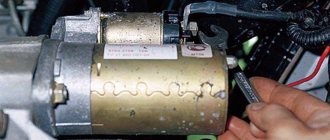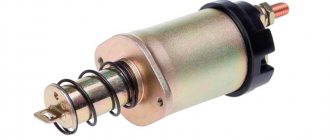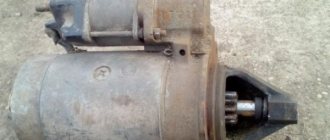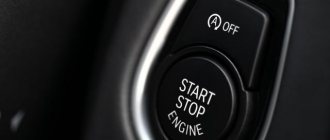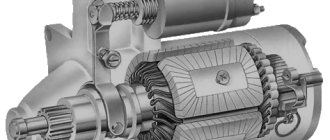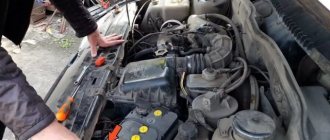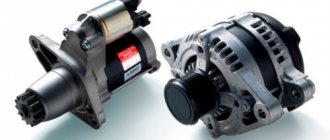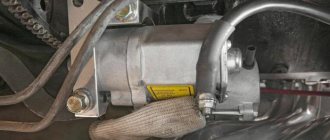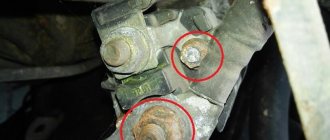Possible reasons why the starter does not turn and how to eliminate them
This malfunction looks like this: In our video you can see that when starting, at first, the starter barely turns the engine, and then it just crackles…. If the battery is severely discharged, the starter will not even try to crank the engine but will immediately make nasty clicking noises.
Your starter is working!
If the starter clicks on a VAZ 2114 and does not turn, then everything immediately becomes clear. These clicks come from the solenoid relay, but this does not mean that you need to change the starter solenoid relay. Current flows to it, which is why it clicks.
If these devices click, then this is not bad, because if there are clicks, then these devices are operational or partially operational. In most cases, solenoid relays use an electromagnetic method to connect contacts.
- the battery is charged with well-connected terminals;
- The ignition switch and its contacts must be in order;
- the starter relay, the solenoid relay and the starter itself.
Rarely on cars with high mileage is it possible for the Bendix to simply stick into the crown tooth. Initially, both the flywheel ring gear and the Bendix teeth have lead-in chamfers, allowing the gears to mesh even if the Bendix tooth does not precisely fit into the gap between the flywheel teeth. Wear over time leads to dulling of the lead-in chamfers, and a situation is possible when a Bendix tooth rests against a flywheel tooth, preventing the retractor relay core from reaching the end of the stroke and closing the power contacts.
You can “revive” the car simply: either short-circuit the terminals on the solenoid relay so that the rotor turns to a different position, or, if there is no convenient access to the starter, turn the crankshaft itself by the generator or power steering pulley using a socket and ratchet. But this is an “emergency” method - you should not postpone repairs, since similar problems will continue in the future.
VAZ 2114 starter connection diagram
A car starter is a DC electric motor and has a rather complex design. During the operation of this unit, various problems may arise, and in order to figure out, for example, why the starter on a VAZ 2114 does not turn, you need to have a good understanding of how it works and how the VAZ 2114 starter switching circuit is designed.
The machine is equipped with an electric starter model 5712.3708. The main parts of this device are:
- the moving part is an armature rotating on a shaft inside a stationary stator on which four magnets are fixed, which are the poles of the stator;
- a traction or retractor relay, which, when the ignition key is turned, sends a signal to unwind the armature;
- Bendix, also known as an overrunning clutch, which is designed to engage the engine flywheel;
- the housing in which all the working elements of the electric starter are located, it is closed with two covers. A solenoid relay is attached to the motor housing.
The main task of this electric motor is to spin up the flywheel of the internal combustion engine, so at the moment of startup it experiences heavy loads when creating torque.
This electric motor is turned on using the ignition switch. When the key is turned, an electrical signal from the battery, through the switch and the mounting block, enters the windings of the solenoid relay. The contacts close and the signal passes to the armature electrical winding.
The starter itself is a power electric motor operating from constant voltage. Additionally equipped with a retractor relay, an overrunning clutch and a bendix (a gear with which the starter directly engages with the flywheel).
When the starter is turned on using the ignition switch, voltage is supplied to the solenoid relay (the relay, by its operating principle, is an electromagnet). An electromagnetic field is generated due to the coil built into the relay. Under the influence of which the connecting fork moves the bendix along the rotor shaft of the electric motor and engages it with the flywheel.
After starting the engine, the rotation speed of the flywheel is several times higher than the rotation speed of the bendix. It turns out that it is not the starter that turns the flywheel, but vice versa. To prevent damage to the electric motor, the overrunning clutch is activated. The gear begins to spin together with the flywheel in a “free” motion, without turning the starter shaft. This continues until the power supply through the ignition switch is stopped.
Experts name several reasons as a result of which the starter stops turning and the car stops starting. The first, most common, is when the battery is discharged. It can discharge in many cases. For example, if the driver does not turn off the lighting devices in the vehicle for a sufficiently long period. This situation can be encountered especially often during winter, when it gets dark early and you have to use additional lighting in the car.
The above problems associated with the operation of the starter are electrical in nature. But experts note a number of other reasons for the failure of this automobile part. They are mainly mechanical in nature. These include wear of the following parts:
- Drive gears (namely, their teeth).
- Overrunning clutch.
- Flywheel ring gear.
These malfunctions are united by one common characteristic feature - a metallic crackling sound when starting the internal combustion engine. Experts explain this phenomenon as follows: in good condition, the electric starter spins the flywheel with virtually no extraneous sounds. The driver will not hear any squeaks or whistles.
Where is the starter relay on the VAZ-2114: photo and location + video
If for some reason your car has stopped starting (turning the engine - approx.), then first of all you need to pay attention to the condition of the starter relay. However, there are two of them in this device, which are radically different both in design and in their purpose.
In this article we will look at each of them in detail, talk about their purpose and location in the car.
Starter relay (retractor) for VAZ-2114
This type of relay is located directly on the starter housing, and is controlled by supplying current from the ignition switch.
This type of relay is directly involved in starting the engine, regulating the clutch reaction between currents of different magnitudes (since the ignition voltage is less than the current supplied from the battery - approx.).
Solenoid relay location
It is not difficult to determine the location of the retractor; it is located directly on the starter and has two wires, the first, the smallest in size, comes from the ignition switch, and the second, the largest in size, comes from the battery.
The location of the wires is indicated by arrows.
The relay is located directly on the starter housing.
Relay operating principle
The operation of this relay is as follows:
- When the battery supplies current to the starter coil, due to the magnetic field, the coil acts on the armature.
- When the armature moves, it clamps the spring, from which the bendix is connected to the splines.
- When the contacts close together, the engine starts, and all connections return to their places, disconnecting the fixation points.
Solenoid relay malfunctions and their symptoms
You can first see if there are problems with the solenoid relay visually, since there may be traces of corrosion on the wires, and as a result, the incoming current may simply not pass to its destination. If cleaning these contacts does not lead to anything, then we move on to inspecting the 4-pin relay, usually located on a bolt in the engine compartment.
The relay location is indicated by a red marker.
Four-pin relay for starter
Another relay that is included in the starter electrical circuit is a conventional four-pin relay, which is responsible for the reliability and integrity of the circuit as a whole.
What is a starter on a VAZ-2114
The starter is one of the main elements of an internal combustion engine. Its function is to drive the crankshaft in the power plant. It does this until the fuel mixture ignites. As soon as this happens, the camshaft will immediately begin to spin on its own, and the car will start.
In normal mode, the VAZ-2114 starter begins its work as soon as the driver turns the key. The entire process can take less than a minute – about fifteen seconds. If this mechanism experiences increased loads during vehicle operation, it may quickly fail and not start. Therefore, it is very important to ensure that the electric starter is in good condition and is correctly attached to the engine block.
Where is the starter relay located on the VAZ 2114?
Two relays are connected to the starter:
- The retractor relay is located above the starter, acting as its mechanism. Its position is shown in the first figure with a general view of the unit and in the diagram of the mechanism itself.
- The next relay is a unit located to the side and is connected by a contact electrical wire to the solenoid relay. This electrical device often breaks down and needs to be replaced, so the car owner needs to know its location in a complex system of components and parts.
Unlike many cars, including VAZ ones, the starter relay on the VAZ 2114 is located in the engine compartment.
And it is a small box like this:
Signs of starter malfunction
- The solenoid relay turns on but makes a knocking noise. It is possible that the relay winding has poor contact with ground. If the wiring and battery are in good condition, you need to open the cover of the starter switch in the relay and stretch or change the ground wire.
- The solenoid relay is activated, but the motor does not turn over. Remove the brush holder cover and check the brushes. In the normal state of the brush, it is pressed tightly against the commutator. If the brush is worn out, the spring will rest against the brush holder and there will be no necessary contact. The height of the brushes must be no less than 12 mm. Replace worn brushes. If there are scratches or marks, the commutator must be sanded. If there is no result, it is better to have the engine checked by a specialist; without special equipment and appropriate skills this will be difficult to do.
- The anchor does not rotate or rotates slowly. There may be a voltage drop in the electrical network. If the electricity supply is in normal condition (battery, terminals, ground wire and brushes are checked). The solenoid relay is disassembled. The contacts are checked (they may burn), the contact disk is turned over to the other side, and the contact bolts are rotated 180 degrees.
- The solenoid relay does not work: The armature winding of the relay has burned out, most often this occurs due to the short circuit of the winding turns. You can determine this by connecting the contacts with a screwdriver. If the result is negative, the relay armature must be replaced.
- The contacts (nickels) are burnt or oxidized. In this case, the solenoid relay is disassembled. Inside there is an armature (a metal cylinder with an internal winding), a spring and a rod. The rod and the hole through which it runs are most often clogged with oxide. Clean with fine sandpaper. The nickels may be oxidized, and their contact surface may also be burnt. Clean and replace if necessary.
- The freewheel (Bendix) may be slipping. It should be disassembled and replaced. If possible, repair broken parts (pushers, rollers, gears). Clean and polish the surface of the coupling.
During operation of the starter, and especially in the cold season. If the starter has not been disassembled for maintenance for a long time, condensation begins to accumulate in it over time. This will not only lead to the formation of oxide, but also to the fact that ice may form inside in cold weather. In this case, of course, you can tap the retractors with a hammer or warm up the starter housing with a torch or blowtorch. But this is temporary, not immediately, but in a month this breakdown will show itself again.
From this we can draw a conclusion. It is necessary to carry out vehicle maintenance on time (especially before the onset of cold weather), this will avoid many unnecessary problems with the car.
- Replacing the fuel pump VAZ 2107 - step-by-step instructions
- Do-it-yourself replacement of a VAZ 2110 fuel pump: step-by-step instructions
- Replacing the fuel pump VAZ 2114 - step-by-step instructions
- Throttle valve for VAZ 2110: checking condition and cleaning
- How to remove the speedometer drive on a VAZ with your own hands
- How to remove a Ford Focus door trim: tips and step-by-step instructions
- Low pressure tires: what are they and how to make them yourself
- How to properly replace a gas tank?
In good condition, the electric starter is activated immediately after turning the key and vigorously spins the flywheel until the valve-piston group starts working. In this case, the driver does not hear any extraneous sounds; the entire starting process takes from five to ten seconds.
Under normal loads, the current generated by the starter is 120-150 A. When heavy loads occur, for example in winter, the resulting current can reach 500 or even 700 A. This is a serious test for this electric unit, so professionals do not recommend holding the key on the start for more than 15 seconds, and repeated startup attempts must be made with a break of at least thirty seconds.
As the electric starter experiences severe stress during operation, problems may arise that manifest themselves in a variety of ways.
The key is turned to start, the VAZ 2114 starter solenoid relay does not work, the starter armature does not rotate.
- First of all, you need to check the wire contacts on the battery and electric starter. It is necessary to clean the lead terminals of the battery and all contacts on the units. Wiring oxidation is the most common cause of a non-functional starter.
- A possible cause of a “silent” electric starter is a discharged or inoperative battery. It is required to measure the capacity of all cans; it must be at least 1.25. If it is lower, you need to charge the battery.
- In one of the electrical windings of the relay, the so-called pull-in winding, a short circuit occurred between the turns. In this case, it is necessary to replace or completely replace the spare part.
- One of the sources of such a failure is a break that occurred in the wiring supplying electric current to the starter traction relay on a VAZ 2114. To find this failure, you need to check the contact between the electric motor plug “50” and the ignition switch plug.
- There is no short circuit between plugs “30” and “50” of the contact part. It is necessary to replace the failed spare part.
- The electric starter armature is stuck. Manually check that it rotates easily.
When trying to start, the starter turns poorly or its armature does not rotate at all, although the solenoid relay is activated.
- This “behavior” of the electric starter is possible when the battery is slightly infected or the lead contacts on the battery are slightly oxidized. The signal from the battery is received, but it is too weak to spin the armature.
- You should also check the contact connections both on the battery and on the traction relay and electric starter. In addition to oxidation, it is necessary to check how well the contact bolts and nuts are tightened, because loose connections also form poor contact and insufficient charge to spin up the electrical unit. If the contacts are loose, a short circuit may form and the wires may burn; they should also be checked.
- This malfunction can occur when the brushes wear out or the commutator burns out. If such damage is detected, then the failed parts must be replaced.
- A more serious reason, requiring complete disassembly of the unit, is a short circuit in the armature winding. In this case, it needs to be replaced.
- At startup, the solenoid relay operates several times and then switches off. At the same time, the starter on the VAZ 2114 does not turn.
- In case of any malfunction, when the starter on a VAZ 2114 does not work, first of all you need to check the functionality of the battery and the absence of oxidation on the contacts. If necessary, you need to charge the battery or clean the contacts from oxides, paying special attention to the wire from the battery to the plug contact “50” on the electric starter.
- If such “symptoms” appear and the battery is fully charged, then perhaps a break or short circuit has occurred in the traction relay winding, which is called the holding winding. In this case, there is only one way out - replacing the relay.
The starter turns on, the armature rotates, but the flywheel does not spin.
- The Bendinx is slipping, after checking the electric motor on the stand, the Bendinx must be changed.
- A similar malfunction can occur if the starter gear gears become unusable. To eliminate the problem, the gearbox must be replaced.
After starting the engine, the starter rotates, but there is a grinding noise, extraneous noise, or sensitive vibration.
- If there is vibration and noise, then you should check the fastening of the electrical unit, it may be loose. In this case, you need to tighten the fastening nuts well.
- Another possible reason is incorrect installation of the electric motor, probably misaligned. It is necessary to correct the distortion and tighten the nuts, and then check that there is no play in the unit body.
- The cover on the drive side may be cracked. The broken cover needs to be replaced.
- The origin of the noise may be the maximum destruction of the bearing shells on the electric starter drive and on the armature. Then replacement of liners or bearings is required.
- Noise and grinding noise occurs when the teeth of the gears of the gearbox, drive or flywheel ring are worn out or destroyed. The only correct solution is to replace gears or failed blocks.
- The source of extraneous noise and vibration may be a bendix that does not disengage or a gear stuck in the flywheel. Remove jamming and clean and lubricate the splines.
The driver must remember that if the starter on a VAZ 2114 does not turn, it means that maintenance of this unit and the battery was not carried out in a timely manner. The ability to start the engine without problems depends on their performance. Therefore, the electric starter and battery require constant attention and care.
We recommend
- Causes of speedometer malfunction on VAZ 2114
- How often should you change spark plugs? Expert advice
- How to remove and replace the starter on a VAZ 2114
- How to replace the license plate light bulb on a VAZ 2114?
Vehicle with manual transmission:
- set the parking brake.
- turn on neutral gear.
- open the hood and prepare a flathead screwdriver.
- turn the key in the ignition switch to the ignition on position.
- Using a screwdriver, we close two contacts on the solenoid relay (as in the video).
- After starting the engine, remove the screwdriver and drive to the repair site.
Checking the starter, checking and troubleshooting the Lada 2114 starter, repair procedure for the Lada 2113 starter, stages of disassembling and assembling the starter of the VAZ 2113, VAZ 2115, VAZ 2114. Diagnostics of the electrical equipment of the Lada 2113. Instructions for repairing the electrical equipment, starter, ignition of the Lada 2114. Check devices, cleaner, lighting Lada 2115
Checking performance If there are doubts about the efficiency of the starter, it is necessary to check it on a stand. The stand must have a socket for installing a starter with a bushing for the front end of the drive shaft.
Connection diagram for checking the starter on a stand: 1 – voltmeter with a scale limit of at least 15 V; 2 – starter; 3 – rheostat 800 A; 4 – ammeter with a 1000 A shunt; 5 – switch; 6 – battery
Electrical connection diagram for checking the starter Lada Samara 2. The connecting wires to the current source, ammeter and contact bolt of the starter traction relay must have a cross-section of at least 16 mm2. The starter temperature during checks should be (25±5) °C, and the brushes should be well ground to the commutator. By closing switch 5, at a current source voltage of 12 V, turn on the starter three times with different braking conditions. For example, at braking torques of 3, 6 and 12 N m (0.3, 0.6 and 1.2 kgf m). The duration of each starter activation should be no more than 5 s, and the intervals between activations should be no less than 5 s. If the starter does not rotate the gear ring of the stand or its operation is accompanied by abnormal noise, then disassemble the VAZ 2113 starter and check its parts.
Test in full braking mode Brake the gear ring of the stand, turn on the starter and measure the current, voltage and braking torque, which should be, respectively, no more than 700 A, no less than 5 V and no less than 13.72 N m (1.4 kgf m ). The duration of activation of the starter should be no more than 5 s. If the braking torque is lower and the current strength is higher than the specified values, then the reason for this may be an interturn short circuit in the armature winding or a short circuit of the winding to ground. If the braking torque and current consumption are below the specified values, then the cause may be oxidation and contamination of the commutator, severe wear of the brushes, hanging brushes in the brush holders, loosening of the brush leads, oxidation or burning of the contact bolts of the traction relay. When fully braking, the VAZ 2115 starter drive shaft should not rotate; If this happens, the freewheel is faulty. To troubleshoot, disassemble the VAZ 2114, VAZ 2115, VAZ 2113 starter and replace or repair damaged parts.
Test in idle mode Remove the gear ring of the stand from engagement with the starter gear. Turn on the starter and measure the current consumed by it and the speed of the VAZ 2114 starter drive shaft, which should be no more than 80 A and 3000 min-1, respectively, with a voltage at the starter terminals of 11.5–12 V. If the current strength and the speed of the drive shaft are different from the indicated values, then the reasons may be the same as in the previous test.
Checking the traction relay
Starter parts: 1 – drive side cover; 2 – sealing gasket; 3 – lever bracket; 4 – traction relay anchor; 5 – traction relay; 6 – “negative” brush; 7 – gasket; 8 – back cover; 9 – brush clamp; 10 – “positive” brushes assembled with a connecting busbar; 11 – brush holder; 12 – stator; 13 – anchor; 14 – tie rod; 15 – armature shaft support; 16 – central gear; 17 – planetary gear; 18 – drive shaft with carrier; 19 – internal gear; 20 – sealing ring; 21 – drive shaft support with liner; 22 – retaining ring; 23 – drive assembly; 24 – restrictive ring; 25 – retaining ring
Install an 11.5 mm thick spacer between restrictive ring 24 and the gear and turn on the relay. The switching voltage of the relay when the gear rests on the spacer should be no more than 8 V at an ambient temperature of (20 ± 5) °C. If the voltage is higher, this indicates a faulty relay or drive.
The starter brushes are worn.
The malfunction manifests itself in the same way as burning of the contact coins (loud clicks when turning the ignition key), the only difference is that when the brushes wear out, the starter will never rotate.
The starter does not start to spin, it is sincerely not observed.
How to start the car?
Unfortunately, it is impossible to start the car with this starter; it must either be repaired or replaced. If the car is equipped with a manual transmission, it may be possible to start it by push or tow.
If the car is equipped with an automatic transmission, it makes sense to call a tow truck or tow truck.
Why doesn't the starter turn on the VAZ-2114?
A common cause of starter failure is the failure of the solenoid relay. This can be determined by a specific click heard from under the hood after turning the ignition key. An audible signal (click) indicates to the driver that the relay is turned on and the overrunning clutch does not have enough power to turn the crankshaft.
Important! This type of starter start is only suitable for cars with electronic ignition, in which the switch regulates the supplied voltage. In older ones, with a contact one, the coil may break when the starter closes.
The starter spins for a long time before starting
We have already written in detail about the situation when the starter spins for a long time during starting!
Expert advice: checking the operation of the starter
If everything is fine with the battery and the contacts too, then the problem is in the starter. and clicks for this reason. What should I do if the starter clicks but does not turn? To diagnose it and find out where exactly the clicks are coming from, you will have to remove the starter.
Then you need to put this starter on the table, take a charged battery and connect ground to the starter body, and connect the positive terminal to the pin that comes after the relay. If the starter turns, then everything is in order and there are no problems with the retractor relay either. And if the starter clicks, but does not turn as before, this means that there is a malfunction in it and you will have to disassemble it and look for the breakdown inside. The same must be done if the starter idles and does not engage.
To identify the reason why the starter does not turn, experts advise using the following instructions:
- We check the wire contacts on both the starter and the battery for oxidation of the wiring:
- clean the battery terminals;
- clean the electric starter contacts.
- Checking the battery charge:
- measure the capacity of the cans;
- its standard indicator is from 1.25;
- if the indicator is lower, then we simply charge the battery.
- We check the pull-in electrical winding of the relay to see if there is a short circuit between its turns:
- We replace the relay with a damaged electrical winding with a new one.
- We check the wiring supplying electric current to the relay on the starter for breaks:
- First we diagnose the electric motor plug;
- Then we diagnose the ignition switch plug.
- We check the ease of rotation of the electric starter armature (this can be done manually):
- If a short circuit occurs in its winding, replace it.
- Check to see if the manifold is burning:
- We replace the failed part.
Problems with the starter on the VAZ 2114 and their elimination
If the car does not start, the starter does not turn, and the traction relay clicks characteristically, then the problem should be looked for in the power circuit. First of all, attention should be paid to the battery. It should not be discharged. You also need to inspect the battery terminals. The presence of oxides can cause the starter connection circuit to have a voltage drop under load. If a discharged battery is detected, it must be charged using a charger. It is recommended to sand oxidized terminals and coat them with conductive lubricant.
To find problems related to the starter, you need to disassemble it. First of all, attention should be paid to the brush assembly. A large current flows through it, which leads to thermal damage. It is important to check that the brushes slide easily in the guides and do not jam. Springs must have sufficiently high elasticity. Any deformation of the brush holders is unacceptable.
The weakest link of the VAZ 2114 starter is four brushes. They are highly susceptible to wear due to friction against the manifold. Therefore, when visually inspecting them, it is important not only to control the absence of thermal and mechanical damage, but also to measure the remaining length. If the size is close to 4 mm, then the brushes must be replaced.
The planetary gearbox contains lubricant. Over time, it thickens and the starter begins to rotate the crankshaft less intensively. Therefore, when disassembling it is important to wash the gears. During assembly, the gearbox must be filled with fresh lubricant.
- Replacing the VAZ 2112 starter relay if necessary
The starter armature is jammed.
The author of the article has encountered such a malfunction several times, but, as a rule, the brushes immediately become unusable and, without analysis, you will not be able to distinguish between armature jamming and brush wear. If, by some miracle, the brushes hold up, then when you turn the key to the start position, you will hear a very loud click, and then, for a while, all the devices will go out (you may feel a specific smell)! Burning out of the mass manifests itself in exactly the same way!
In any case, the car will not go anywhere on its own. It is necessary to carry out diagnostics and use a tow truck/tug to proceed to the repair or parking area.
Device and connection diagram of the VAZ 2114 starter
VAZ 2114 starter connection diagram
A car starter is a DC electric motor and has a rather complex design. During the operation of this unit, various problems may arise, and in order to figure out, for example, why the starter on a VAZ 2114 does not turn, you need to have a good understanding of how it works and how the VAZ 2114 starter switching circuit is designed.
The machine is equipped with an electric starter model 5712.3708. The main parts of this device are:
- the moving part is an armature rotating on a shaft inside a stationary stator on which four magnets are fixed, which are the poles of the stator;
- a traction or retractor relay, which, when the ignition key is turned, sends a signal to unwind the armature;
- Bendix, also known as an overrunning clutch, which is designed to engage the engine flywheel;
- the housing in which all the working elements of the electric starter are located, it is closed with two covers. A solenoid relay is attached to the motor housing.
No power plus is supplied to the starter.
For clarity, look at this picture: Without a test light or multimeter, you will not determine this malfunction! And in general, without instruments, it can be confused with brush wear!
As you can see, if the power wire running from the battery to the solenoid relay breaks, the starter will not work, but the solenoid relay will click. If, upon visual inspection of the direct battery-starter wire, you do not see any damage, call a tow truck and go to the place of repair and diagnostics.
Causes of starter failure on a VAZ 2114
Incorrect operation of the starter, like any other unit, can be a consequence of one of the reasons:
- Increased load.
- Wear of a part due to the expiration of its temporary life.
- Factory defect.
- Gross violation of operating standards.
One of the unspoken problems that accompany the breakdown of the starter on the VAZ 2114 is considered to be a design error at the manufacturer. Its essence is that the engineers made some miscalculation and did not calculate the power of this part, making it weaker than necessary. Perhaps the reason lies in the reduced size of the case.
On cold frosty days, the engine does not start well, the starter experiences increased load and may also fail. Poor fastening and increased vibration loads also negatively affect the safety of this unit. A manufacturing defect in the form of poor-quality distribution of lubricant near the core and housing leads to a failure in the area of the solenoid relay, which stops working the first time.
Starter design
Regardless of the specific design (geared/gearless, with or without a stator winding), the electric starter includes a solenoid relay. This electromechanical unit performs two functions simultaneously:
- It pushes the bendix and drive gear forward, allowing it to mesh with the flywheel ring gear.
- It relieves the load on the ignition switch contacts: the current consumed by the starter is large, and the solenoid relay allows you to control the starter using a relatively small current.
The design of the solenoid relay is simple: its body houses two windings of different power, which draw in (hence the name) the core. A fork is installed on the core, which moves the bendix through a lever, and at the end of the stroke the core closes power contacts (“nickels”) that supply power to the starter directly from the battery.
Starter core
The starter core may simply jam inside the winding due to dirt or rust, which will also cause the starter to click. It is not necessary to have a decent mileage for this. For example, the author has seen this on RenaultFluence and Latitude many times on a new car.
The “repair” here is simple: just rest a hard object (for example, an extension cord from a tool kit) against the body of the solenoid relay and apply a sharp but light blow to it. After this, the solenoid relay almost always restores its functionality without serious problems in the future and the clicks disappear.
The contacts of the solenoid relay have to switch a very large current - for example, a conventional kilowatt electric starter consumes more than 400 amperes at the moment of switching on, the starting current of electric motors is several times higher than the rated one. When the starter is turned off, a spark occurs in the opening contacts, leading to erosion - as a result, at one moment the relay is unable to supply power to the starter windings.
The treatment recipe here has been known since Soviet times - motorists knew firsthand about cleaning nickels. However, now cars often use non-separable retractor relays: in this case, the retractor assembly will have to be replaced.
If the holding winding breaks or burns out, the motor will not be able to start: as soon as the “nickels” are closed, the return spring, the elasticity of which is not counteracted by the holding winding, will break the circuit. At the same time, the holding winding will work again, and a characteristic high-frequency crackling sound will be heard from under the hood.
You can check the condition of the winding even without an ohmmeter by removing the starter and connecting it directly to the battery (body to ground, positive power terminal to both retractor terminals, power and control). If you use a flat screwdriver to “help” the bendix to remain in the extended state, then the starter with a faulty retaining winding will spin smoothly.
The starter itself may also be faulty - the solenoid relay normally supplies power, but this is of no use. Most starters have a permanent magnet stator and only have a winding on the rotor. Wear on the commutator brushes or lamellas will result in the starter being unable to rotate under normal power conditions.
The “old-fashioned” method of checking is very simple, and if the starter is sufficiently accessible from under the hood, it will not even require removing the starter. Carefully close the power contacts on the solenoid relay body with a screwdriver or wrench (attention - do not touch the “ground” while doing this!).
In this case, power will go to the starter winding directly without the participation of a solenoid relay. In addition, this method is safe, since without the activation of the retractor relay, the starter will not engage with the flywheel, and there will be no risk of accidentally starting the car while it is in gear.
If the starter is turned on directly and spins without problems, then the retractor is to blame. The second “old-fashioned method” of final checking is crude, but no less effective in garage conditions: you need to try to brake the bendix of a working starter with a strong object (usually the flat side of a hammer is pressed against the gear).
The use of widely used multimeters to test the starter is ineffective: even the resistance of their measuring probes is often itself comparable to the resistance of a separate winding. The only thing you can count on is the possibility of testing the rotor to ground in search of short circuits.
Starter relay for VAZ 2114 – where it is located, repair and replacement
A discharged battery or problems with the starter prevent the power unit from automatically starting. Drivers of cars with a rear drive axle remember the meaning of the words crank, ratchet. A device with asymmetrical, oblique slots was screwed into the crankshaft pulley nut. The toothed crown allowed the handle to be rotated clockwise. Owners of cars with front-wheel drive are deprived of the opportunity to correct the situation through physical effort. The main hope on the trip is to understand the operating principle of the starting mechanism and the availability of spare parts. The article will tell you where the starter relay is located on a VAZ 2114, what are the signs of a malfunction, and how to replace the defective part yourself.
Preliminary safety notes
Voltage above 36 volts is considered dangerous to humans. Electric shock of 0.1 ampere is fatal. The situation is aggravated by high humidity and metal flooring.- The starter is a DC electric motor capable of delivering 260 amps at maximum load.
- Interfering with bare hands or metal tools into the current circuits of a switched-on unit is dangerous to health. Dismantling, repairs, and installation must be performed with the battery power turned off.
- Testing windings for interturn short circuit and insulation breakdown to ground is performed with a megger. The generator of the measuring device produces voltage up to 2500 volts. It is prohibited to touch the contacts during the verification process.
- Electric motor equipment requires care and experience. Printed and electronic publications are not deprived of the right to errors or typos. An incorrect wrench size will quickly become apparent. A play on Russian words will sound, untranslatable into foreign languages. Things will go further. The inaccuracy of the diagram is hardly noticeable.
- At the first symptoms of uncertainty or lack of knowledge, you should contact a professional auto electrician. The safety of car wiring and on-board electronics is valued above personal ambitions.
Where is the starter relay located on a VAZ 2114
The relay is a component of the vehicle starting device. The purpose and location of the element will become clear after considering the functioning of the entire unit.
- The car owner turns the ignition key to the start position. The switch closes the power circuit of the relay coil - the plus of the battery is supplied to contact “50”. The current passing through the turns creates an electromagnetic field. Electromagnetic induction forces act on the relay armature. The return spring is compressed. The starter fork moves the freewheel. The Bendix splines engage the flywheel ring gear. The power supply circuit of the holding winding is closed. The second coil, by analogy with the first, becomes an electromagnet. Self-retention occurs.
- A characteristic click is heard - audio confirmation of the retraction process. The traction winding is de-energized. A voltage of 12 volts reaches the carbon brushes of the electric motor. The starter armature begins to rotate and drives the crankshaft through the flywheel. It takes up to 10 seconds for the engine to start. Longer exposures are not recommended.
- Successful start - the key returns to its previous position. The relay is no longer energized. The spring expands. The relay goes back. The clutch loses traction. The starter goes silent. Failure leads to repetition. In the winter season, to save the battery, morning starting is performed in the garage using a special starting-charger. You can sympathize with homeless cars.
- After three attempts, it’s worth thinking about the real reasons for failure. The voltage source has died down. The spark plugs on carburetor models were flooded. The spark is gone. Problems with fuel supply. The list goes on. The VAZ 2114 starter relay may be the root cause of the breakdown, among other options.
Signs of a faulty retractor relay on a VAZ 2114
Remember the basic rule of electricians in a timely manner. There are two faults in electricity:
- lack of contact at the required point;
- presence of a connection in an unnecessary place.
The essence of the problem. There was a suspicion of a problem with the starter. Symptoms of inoperability of the components of the starting mechanism are similar. The search for the weak link must be performed consistently during comprehensive testing.
- Use a load plug to measure the battery voltage. Indicators are below normal - charge.
- Remove, clean, lubricate the power wires and battery terminals. Connect, secure.
- Check the contact group of the ignition switch. Touch the terminals with an insulated wire with cleaned ends to simulate the operation of the key. The process has begun - replacing the lock.
- The next multifunctional part is the ignition relay, covered with a protective steering column cover. In addition to participating in connecting the starter, the switching element performs a number of other operations: turning on the windshield wipers and heating the windows. Current overloads cause overheating and breakdown. There are several verification methods:
- replace with a known good part.
- test with a multimeter in resistance measurement mode. When 12 volts are supplied to contacts 85, 88, the device between points 30, 87 should show 0 ohm. The absence of tension is infinity.
- Briefly bridge the sockets of the block 30, 87.
- apply “+12 volts” directly to the red screw of the solenoid relay (focus on the traditionally connected standard red wire). A positive result indicates a defective part. The repair method is replacement.
- Solenoid relay testing. If the event from the previous paragraph did not trigger the response, perform contact prevention.
- Disconnect the negative terminal. Using a size 10 wrench, remove the nuts, remove dirt and oxidation. Treat with lubricant. Collect. Restart. A negative outcome casts a shadow on the traction relay. Using a screwdriver with a plastic handle, briefly close the contact bolts. The starter spun - the culprit has been discovered.
- Possible insulation breakdown, breakage of the pull-in winding turns does not allow creating a sufficient field. Interturn short circuit and ground penetration are checked with a megger. Desperate craftsmen use wires with a 220 volt light bulb, an alternating power supply network. The tester can show a break.
- If the jumper fails to achieve a positive result, you need to remove and repair the starter.
- A situation occurs: the relay is pulled in, the starter starts to turn on, and the starter stops rotating. The holding winding is assumed to be in poor condition. It is tested in the same way as the previous coil. Summary - replacing the traction relay.
- Another violation of the starting mechanism functioning algorithm is detected when the engine is turned on. The crankshaft ring with the starter gear does not disconnect. There are knocks. A working overrunning clutch does not allow turning the starter into a generator. It is urgent to turn off the engine. In addition to wear and distortion of the metal parts of the mechanism, stuck contact pins of the solenoid relay can cause problems. The solution is clear. Dismantle the unit. Disassemble, find defect. Replace the worn component, clean, lubricate. Assemble, check, install back. It is preferable to entrust complex starter repairs to a specialist.
Replacing the starter relay on a VAZ 2114
The World Wide Web offers two options to fix problems with the solenoid relay:
- change the faulty part directly in the engine compartment, head down, neglecting cramped conditions;
- Remove the starter assembly and eliminate the problematic module on a workbench.
Selecting the first item assumes one hundred percent confidence in the correctness of the diagnostics performed and in the ideal condition of the remaining components. Minimum time spent to eliminate a momentary defect.
The alternative version offers comprehensive maintenance and repair.
Starter relay installation diagram
How to replace the starter relay
- Disconnect and remove the battery.
- Remove the air filter.
- Disconnect the connected wires.
- The VAZ 2114 starter is secured with three studs and nuts to the gearbox housing. It is convenient to unscrew the two nuts from above. The third is visible from below. If the car is in an inspection hole, you need to remove the metal mudguard to gain access. On level ground you will have to work by touch.
- The device is on the table. Unscrew the tightening bolts. Disconnect the VAZ 2114 starter relay. Insert a new part. Reassemble in reverse order.
